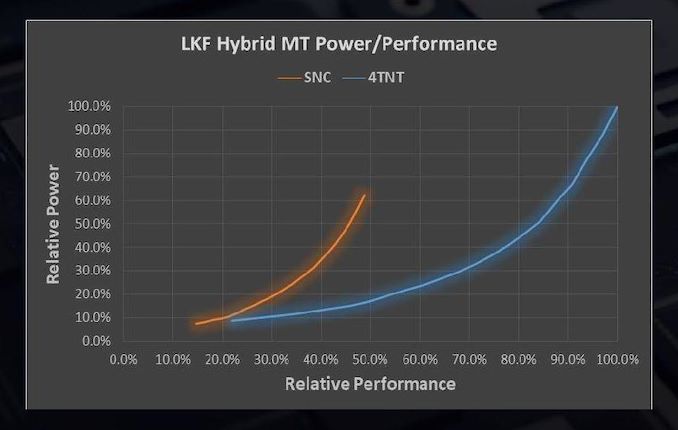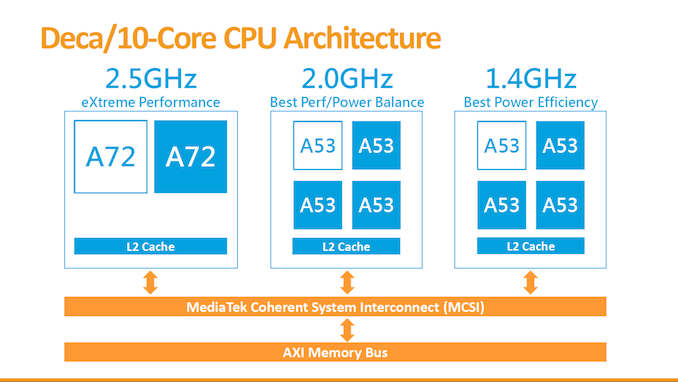The Intel Lakefield Deep Dive: Everything To Know About the First x86 Hybrid CPU
by Dr. Ian Cutress on July 2, 2020 9:00 AM ESTHow To Treat a 1+4 Hybrid CPU
At the top of the article, I explained that the reason for using two different types of processor core, one big on performance and the other big on efficiency, was that users could get the best of both worlds depending on if a workload could be run efficiently in the background, or needed the high performance for a user experience interaction. You may have caught onto the fact that I also stated that because Intel is using a 1+4 design, it actually makes more sense for multi-threaded workloads to run on the four Atom cores.
Using a similar power/performance graphs, the effect of having a 1+4 design is quite substantial. On the left is the single core power/performance graphs, but on the right is when we compare 1 Sunny Cove to all 4 Tremont cores working together.
Where the previous graph considered a 1+1 design, which is more relevant in those user experience scenarios listed above, on the right is the 1+4 design for when the user demands a heavier workload that might not be latency critical. Because there are four Atom cores, the blue line multiplies by four in both directions.
Now obviously the real world scenario is somewhere between the two, as it is possible to use only one, two, or three of the smaller cores at any given time. The CPU and the OS is expected to know this, so it can govern when workloads that can be split across multiple cores end up on either the big core or the small core.
In this graph from Intel, we have three distinct modes on which threads can operate.
- ‘Sunny Cove/SNC’ is for responsiveness and user experience threads,
- ‘Tremont/TNT Foreground’, for user related tasks that require multiple threads that the user is waiting on.
- ‘Tremont/TNT Background’, for non-user related tasks run in efficiency mode
Even though the example here is web browsing, it might be best to consider something a bit beefier, like video encoding.
If we run video encoding, because it is a user related task that requires multiple threads, it will run on the four Tremont cores (TNT FG). Anything that Windows wants to do alongside that gets scheduled as TNT BG. If we then open up the start menu, because that is a responsiveness task, that gets scheduled on the SNC core.
Is 1+4 the Correct Configuration?
Intel here has implemented a 1+4 core design, however in the smartphone space, things are seen a little differently. The most popular configuration, by far, is a 4+4 design, simply because a lot of smartphone code is written to take advantage of multiple foreground or multiple background threads. There are a number of cost-down designs that reduce die area and power by going for a 2+4 implementation. Everyone seems adamant that 4 is a good number for the smaller cores, partly because they are small and cheap to add, but because Arm’s quad-core implementation is a base unit for its IP.
The smartphone space in recent quarters has also evolved from a two tier system of cores. In some of the more leading edge designs, we now have three types of core: a big, a middle, and a small. Because of the tendency to stay with eight core designs, we now get 1+3+4 or 2+2+4 designs, powered by complex schedulers that manage where to put the threads for the best user experience, the best battery life, or somewhere in the middle. Mediatek has been famously dabbling in 10 core designs, going for a 2+4+4 approach.
One thing missing from all of these implementations is an SoC with one big core and four small cores. Smartphone vendors don’t seem to be interested in 1+4 silicon, and yet Intel has decided on it for Lakefield. This is borne out of decisions made on both sides.
From the smartphone perspective, when hybrid designs came about, the big cores just weren’t powerful enough on their own. In order to offer something more than simply basic, at least two cores were needed, but because of how Arm architected the big and little designs, it almost became standard to look into 4+4 implementations of big and small cores. It was only until this configuration was popularized over a couple of years, and Arm big cores got more powerful, that chip designs started looking at 2+4, or 1+3+4 designs.
On Intel’s side of the fence, the biggest problem it has is the size of the Sunny Cove core. By comparison, it’s really, really big. Because the graphics core is the same as Ice Lake and reuses its design, there simply isn’t enough room within the 82 mm2 compute die to add another core. Not only that, but there is a question of power. Sunny Cove wasn’t built for sub-1W operation, even in the Tremont design. We see big smartphone silicon pulling 4-5W when all eight cores are active – there is no way, based on our understanding of Intel’s designs, that we could see four (or even two) Sunny Cove cores being in the optimal performance per watt range while being that low. Intel’s Lakefield graphics, with 64 EUs, is running at only 500 MHz – a lot lower than the Ice Lake designs. Even if Intel moved that down to a 32 EU design to make space for another Sunny Cove core, I reckon that it would eat the power budget for breakfast and then some.
Intel has made the 1+4 design to act as a 0+4 design that sometimes has access to a higher performance mode. Whereas smartphone chips are designed for all eight cores to power on for sustained periods, Lakefield is built only for 0+4 sustained workloads. And that might ultimately be its downfall. This leads onto a deep discussion about Lakefield’s performance, and what we should expect from it.














221 Comments
View All Comments
EthiaW - Tuesday, July 7, 2020 - link
How can we expect something that stingy on silicon area (don't have place for a single more large core) to compete with a snapdragon 9cx (likely with two Cortex-X1)or apple a14? Actually it has no edge over apple a12 from 2018 even the latter faces some 40% performance lost in x86 simulation.Wilco1 - Wednesday, July 8, 2020 - link
It doesn't even compete with the 18 month old 8cx... It will be interesting to see a side by side Book S review with benchmarks and battery life.serendip - Tuesday, July 14, 2020 - link
https://www.notebookcheck.net/Samsung-Galaxy-Book-...Here it is. It barely competes against the 8cx but gets almost half the battery life running at 5W TDP. Samsung is supposed to release an update to allow running at 7W but that would kill battery life even more.
Wilco1 - Wednesday, July 15, 2020 - link
Ouch... Thanks for that link!reggjoo1 - Tuesday, July 7, 2020 - link
Just manipulating the scheduler, won't be enough. They're gonna have to work on the governor more.808Hilo - Sunday, July 12, 2020 - link
Headline:Intel expanded its turd business!
We successfully, and at great cost, replicated the Atom processor and are only 10 years late with our consumer grade chip. The improvements are amazing: 1 slow processor supported by 3 superslow processors in a revolutionary new 4 processor die. The chip, designed for warheads, is exclusively down binned and handselected for exacting consumer standards. Support our military. Desining low performance is not cheap. Getting effed - Intel inside!
throAU - Monday, July 13, 2020 - link
So, unless this can compete with the iPad Pro processor of the day, I just don't see the market. Windows 10 on ultra portable tablet type devices already sucks. So your realistic choices are android and iOS. Android has a suite of decently performing, already existent SOCs on the market, likely at far less cost than intel will no doubt try to charge for this. And no AVX-512? Only a single performance core? I just don't see it working out.I would have thought they'd be far better off not neutering the Sunny Cove core, and working with Microsoft/others on an API for workload queuing to the relevant core for a relevant code fragment. Treat the performance core as you would any other co-processor. Use thread affinity to bind specific UI threads to it. I'm sure there are methods that could be used but no - in order to run on unmodified platforms (that suck for the market segment they are aiming at anyway) - they crippled it.
serendip - Tuesday, July 14, 2020 - link
Notebookcheck has a review comparing the Intel Lakefield and ARM models of the Galaxy Book S:mhttps://www.notebookcheck.net/Samsung-Galaxy-Book-...The results aren't pretty. For the same price of around $1000, the Lakefield version loses LTE in some markets, has equal or slightly less performance for CPU and GPU, but it has <10 hour battery life compared to the 8cx model's 16 hours. Despite all the fancy packaging, Lakefield is still half as efficient as Qualcomm's best, which makes it outclassed by Apple's silicon.
The worst part about Lakefield on Windows is how it essentially performs as a quad core Atom chip most of the time. Ian's fears were realized.
throAU - Tuesday, July 14, 2020 - link
This is pretty much exactly what I expected. Except the modern ARM processors have a better feature set than a crippled Lakefield chip. And there's less fragmentation in what they will/will not support vs. other ARM processors of the day.I expected Qualcomm to outclass it. It won't even be anywhere near close an A12Z and that's a processor from 12-18 months ago, which will no doubt be outclassed itself by whatever apple release late this year.
ballsystemlord - Wednesday, July 22, 2020 - link
Spelling and grammar errors:"For those that are interested, Lakefield's PMICs are under the codenames Warren Cove and Castro Cover, and were developed in 2017-2018."
I think you misspelled "cove":
"For those that are interested, Lakefield's PMICs are under the codenames Warren Cove and Castro Cove, and were developed in 2017-2018."
"Even those these CPUs are a 1+4 configuration,..."
"though" not "those":
"Even though these CPUs are a 1+4 configuration,..."
"Another thing to note, which Intel glossed over, that most people are going to be really concerned about."
Missing "is" and concerned about what?
"Another thing to note, which Intel glossed over, is that most people are going to be really concerned about."